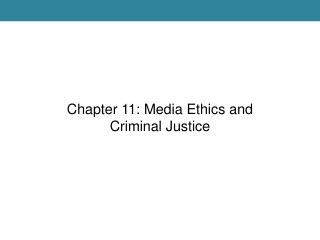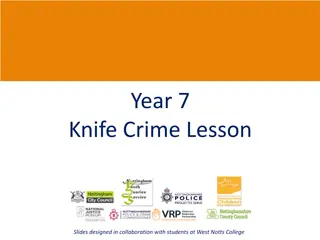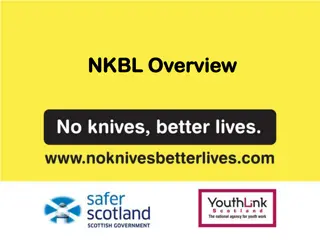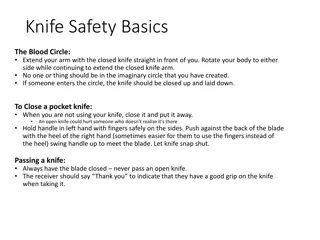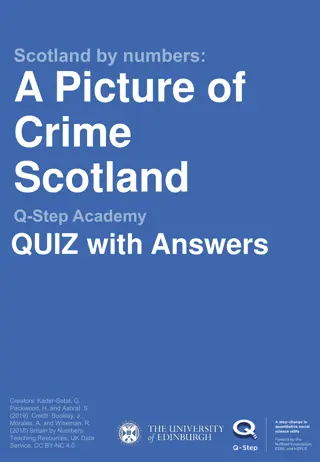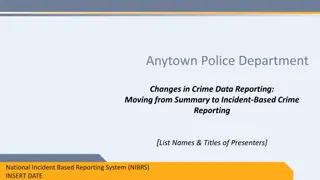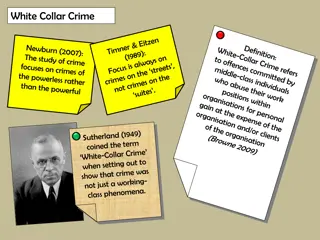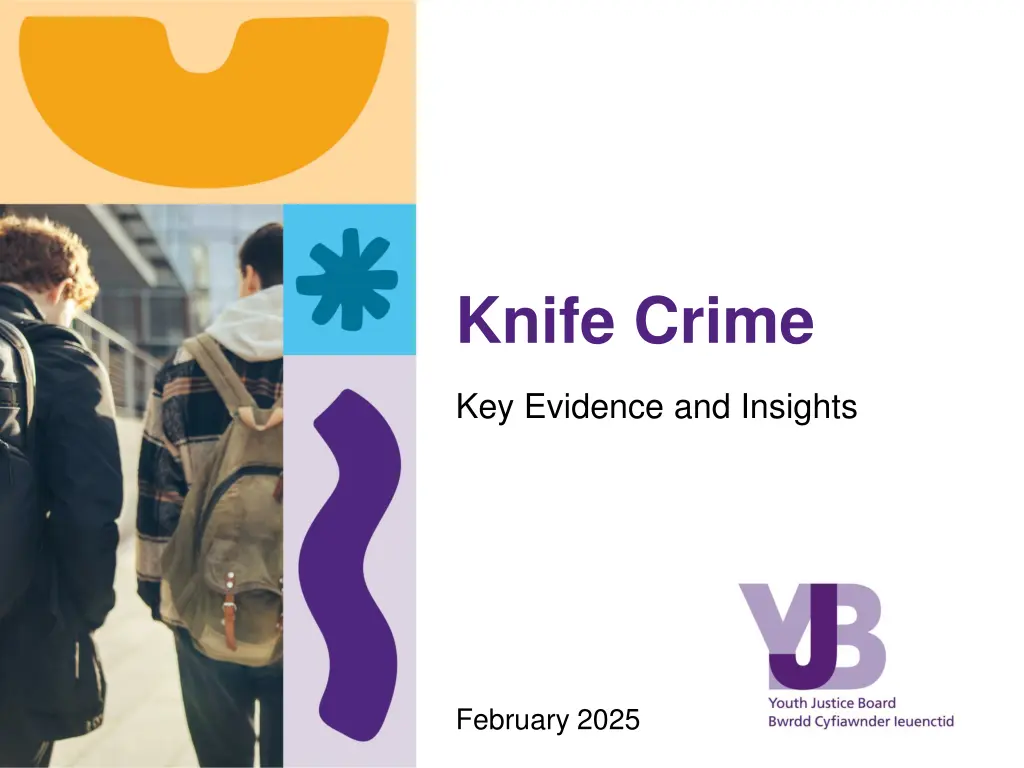
Insights on Knife Crime Prevalence and Offences in England and Wales
Explore key insights into the prevalence and types of knife crime in England and Wales, focusing on children's involvement, possession offenses, and hospital admissions for assault with a sharp object. Understand the data trends, disparities, and implications for criminal justice practices.
Download Presentation

Please find below an Image/Link to download the presentation.
The content on the website is provided AS IS for your information and personal use only. It may not be sold, licensed, or shared on other websites without obtaining consent from the author. If you encounter any issues during the download, it is possible that the publisher has removed the file from their server.
You are allowed to download the files provided on this website for personal or commercial use, subject to the condition that they are used lawfully. All files are the property of their respective owners.
The content on the website is provided AS IS for your information and personal use only. It may not be sold, licensed, or shared on other websites without obtaining consent from the author.
E N D
Presentation Transcript
OFFICIAL Knife Crime Key Evidence and Insights February 2025 OFFICIAL
OFFICIAL Prevalence of knife crime OFFICIAL
OFFICIAL Prevalence of knife crime Knife crime is not just concerned with child populations Key Messages The MoJ recorded 18,560 knife crime offences resulting in caution of conviction in the year ending March 2024. Only 17% (3,206) of these offences were related to children, with the remaining 83% being concerned with those over the age of 18. Children make up a minority about a sixth of knife crime offences overall in England and Wales. The number of knife crime offences committed by children has been decreasing since the year ending March 2019, with children making up 20% of all knife crime offences in that year to 17% in the latest year. Black children made up 14% of knife offences in the year ending 2024. Given that they make up 6% of the general population in the 2021 census data, this shows clear over- representation. Also Mixed ethnicity children made up 10% of knife offences while making up 8% of the general population. Disparity in offences is influenced by a range of factors including much higher use of stop and search for Black children, and greater likelihood of social marginalisation including economic deprivation. Black and Mixed ethnicity children are over-represented in knife offences. There are a range social factors that influence these outcomes as well as disparity in criminal justice practice including stop and search. Number of knife and offensive weapon offences committed in England and Wales by age group 20,000 17,500 15,000 Offences 12,500 10,000 7,500 5,000 2,500 0 2014 2015 2016 2017 2018 2019 2020 2021 2022 2023 2024 Year ending March Aged 18 and over: Total number of offences Aged 10 - 17: Total number of offences Source: MoJ, Knife and Offensive Weapon Sentencing Statistics Year ending Q1 2024, Main Tables 02/05/2025 3 OFFICIAL
OFFICIAL Prevalence of knife crime Key Messages There are differences in the types of knife offences by children More than 99% of children convicted of knife offences are for possession alone rather than using it for threatening purposes or for knife enabled-serious violence. The MoJ has identified possession of a knife as the most common knife crime offence committed by children. More than 99% of knife offences are for possession alone. Number of knife crime offences committed by children in England and Wales 5,000 The data used in this evidence pack is from the Ministry of Justice and focusses on sentencing relating to specific possession and threatening offences. The MoJ release is a subset of knife crime. Knife crime as a broader issue requires data from a range of other departments to fully understand it. 4,000 Offences 3,000 2,000 1,000 0 2014 2015 2016 2017 2018 2019 2020 2021 2022 2023 2024 Year ending March Aged 10 - 17: Possession Offences Aged 10 - 17: Threatening Offences Source: MoJ, Knife and Offensive Weapon Sentencing Statistics Year ending Q1 2024, Main Tables 02/05/2025 4 OFFICIAL
OFFICIAL Prevalence of knife crime Key Messages The number of hospital admissions for assault by sharp object are changing over time Hospital admissions for assault with a sharp object is 46% higher than it was in 2013 but has been falling from a peak in 2019. The NHS reported a total of 68,768 external cause admissions in the year 2022-23. 458 hospital admissions in this period were because of assault by sharp object. This is a 2% decrease from the previous year and a 46% increase from the year ending March 2013. Of the 458 admissions for assault by sharp object, this included 63 admissions aged 10-14, 103 admissions aged 15, 128 aged 16, and 164 admissions aged 17. This is the most recent data available at the time of publishing. These statistics relate to the age of the victim; therefore, we do not know the age of the perpetrator in these instances. 10- to 17-year-old Hospital Admissions for Assault by Sharp Object, in England 700 600 500 400 300 200 100 0 2013 2014 2015 2016 2017 Year ending March 2018 2019 2020 2021 2022 2023 02/05/2025 5 Source: NHS, Hospital Admitted Patient Care Activity, External Causes OFFICIAL
OFFICIAL Why children carry knives OFFICIAL
OFFICIAL Why children carry knives Key Messages Social Status Fear and Victimisation There is an overlap between victims and those who use knives Children may carry a knife to gain social status amongst peers, maintain their reputation and gain respect of others (Nacro 2020; Silvestri 2009; Smith & Hughes 2019). Experience of social exclusion and lack of educational attainment may result in children engaging in knife carrying to gain social status (Lemos 2004). Children feel the need to protect themselves and perceive knives as an easily accessible way to do so (Smith & Hughes 2019). Children who carry knives are likely to have been a victim of violence or carry a knife out of fear of victimisation (Eades et al. 2007;Traynor 2016). The YEF Violence and Vulnerability 2023 survey shows that 48% of children who committed violence were also victims (YEF 2023). Current evidence suggests that knife crime is driven by a combination of poverty, marginalisation, adverse childhood experiences (ACEs), trauma, fear and victimisation, including exploitation (HMIP, 2022) Exploitation Deprivation Evidence suggests a link between deprivation, high levels of violence and knife offences (Traynor 2016). The presence of poverty and lack of employment and material support can create pathways into offending behaviour (Silvestri et al. 2009). Children carrying knives has been related to gang and drug-related activity children are particularly susceptible where they have no positive role models (Nacro 2020). Working with children who are at risk of exploitation by gangs or county lines drugs operations has been recognised as a priority (HMIP 2022). Adverse Childhood Experiences (ACEs) The level of fear and societal issues experienced by children are legitimate and must be addressed to promote understanding of risk and consequential thinking Social Media Although evidence captures some of the drivers for why children carry knives, it is difficult to establish the prevalence of the reasons behind knife carrying Practitioners and policymakers have suggested that the role of technology and social media in facilitating serious violence is a significant blind spot . Anecdotal evidence suggests that since COVID-19, gangs are increasingly reliant on use of encrypted social media platforms to groom, exploit and coerce young people (Crest Advisory 2022). ACEs have been suggested to impact children s responses to situations, with strong associations made to aggression, violence and criminal behaviour. The trauma and absence of feelings of safety associated with ACEs are suggested to shape influence knife carrying (Gray, Smithson & Jump 2021). 02/05/2025 7 OFFICIAL
OFFICIAL What works to reduce knife crime OFFICIAL
OFFICIAL What works in reducing knife crime The programmes of focus in the following slides are individual child level programmes. However, this is part of a wider context of programmes including community level approaches, as well as those which target supply or organised crime exploiting children. Universal Prevention Universal interventions involve programmes, schemes and campaigns that are implemented on a broader scale and may be tailored to the general population rather than being targeted at a specific group. These may be intended to raise awareness and promote knowledge on specific crime problems. Early Prevention The YJB definition of Early Prevention is support for children (with no linked offence) to address unmet needs / welfare concerns, usually delivered by mainstream and voluntary sector services. Targeted Prevention The YJB definition of Targeted Prevention is specialist support for children who have had some contact with criminal justice services but are not currently being supported through diversion, an out of court disposal or statutory order (this could include children who have had previous YJS intervention). This is to address unmet needs / welfare concerns. The aim is to improve outcomes through positive interaction while minimising harmful experiences for children. Diversion The YJB definition of Diversion is where children with a linked offence receive an alternative outcome that does not result in a criminal record, avoids escalation into the formal youth justice system and associated stigmatisation. This may involve the YJS delivering support / intervention that may or may not be voluntary and/or signposting children (and parent/carers) into relevant services. All support should be proportionate, aimed at addressing unmet needs and supporting prosocial life choices. Formal Sentencing Formal Sentencing is the judicial process where a judge or magistrate determines and announces the legal consequences for a person who has been found guilty of a crime. Sentences may vary depending on the seriousness of the crime that has been committed. 9 OFFICIAL
OFFICIAL Current options to respond to children found in possession of a knife Court disposal following charge and conviction: courts can use sentences including referral orders and youth rehabilitation orders. With a referral order, a separate panel, rather than the court determines the conditions following an assessment. The panel is comprised of volunteers from the community, supported by youth justice workers. With a youth rehabilitation order, the court determines the requirements and the timescale for completion, informed by a youth justice worker s pre-sentence report. Formal out of court disposal: Cautions and youth conditional cautions (YCC) can be used as an alternative to court action. This has to be agreed by the police and prosecutors, after consultation with youth justice workers. Youth justice workers may carry out an assessment and recommend requirements for a YCC. Informal out of court disposal: Informal out of court disposals may be used including community resolutions. Some of these are issued by the police on their own including warnings and informal resolution including apologies and reparation. There are also more rigorous deferred prosecution schemes (outcome 22). This approach is taken where diversionary, educational or intervention activity is undertaken, usually under the supervision of a youth offending team. Police usually consult with youth just workers before using deferred prosecution and youth justice workers may undertake an assessment. HM Inspectorate of Constabulary support the use of deferred prosecution in appropriate cases of knife possession. 10 02/05/2025 OFFICIAL
OFFICIAL What works: What is the evidence telling us? The following programmes mostly look at the impact on violent crime more generally but can be applied in the instance of knife crime offences. Focused Deterrence: Strong evidence this has a high impact on violent crime - estimated to reduce violent crime by 33% (YEF Toolkit). Targeted Prevention Programmes: Varying evidence and impact on violent crime. These are also used as part of diversion, not just prevention. Important to note that this is based on US-based evidence and one study from Glasgow. Social Skills Training: Strong evidence this has a high impact on violent crime - estimated to reduce violent crime by 32%. Mentoring: Moderate evidence this has a moderate impact on violent crime - estimated to reduce violent crime by 21%. Sports Programmes: Limited evidence this has a high impact on violent crime. These programmes have been found to reduce aggression, promote mental health and respond to other behavioural difficulties (YEF Toolkit). A&E Navigator Programmes: Very limited evidence this could have a high impact on violent crime, Estimate is based on two US studies only. The YEF has funded a multi-site trial of this intervention, which they intend to evaluate (YEF Toolkit). Violence Reduction Units (VRUs): Evaluations suggest a reduction in police recorded violence without injury offences. Whilst not statistically significant, there were encouraging indications of reductions in homicides and hospital admissions resulting from any violent injury (for example, not just sharp object) (Home Office 2023). Pre-Court Diversion: Strong evidence this has a moderate impact on violent crime - estimated to reduce re-offending by 13% and in the instance of another offence, this is likely to be less serious (YEF Toolkit). Hot Spot Policing: Moderate evidence this has a moderate impact on violent crime - estimated to reduce violent crime by 14% and overall offending by 17%. The nature of delivery is important - it is found to be most effective when taking a problem- oriented policing approach compared to traditional policing (YEF Toolkit) A Home Office (2024) Analysis of Hot Spot Policing (covering children and adults) found reduced crime on patrol days compared with non-patrol days, although at the force level few forces demonstrated a significantly significant reduction in crime. Tailored Support Opportunities (Housing, Education, Employment): Strong evidence this has a high impact on reducing weapon carrying (Browne et al. 2021). 11 OFFICIAL
OFFICIAL What works: What is the evidence telling us? The following programmes are less effective, or have weaker evidence or may be harmful Knife Crime Education Programmes: Very weak evidence which is insufficient to establish their impact on violent crime. It has been argued however that this intervention can contribute to misconceptions about knife carrying and subsequently increase children s likelihood of carrying a knife out of fear for their safety (YEF Toolkit). Knife Surrender Schemes:Very weak evidence which is insufficient to establish their impact on violent crime. However, two UK-based studies suggest that whilst these schemes may contribute to a small reduction in knife crime, these reductions are not sustained for long (YEF Toolkit). Media Campaigns:Very weak evidence which is insufficient to establish their impact on violent crime. Some low-quality studies however suggest media campaigns can contribute to perceptions of fear and threat and increase the likelihood of knife carrying (YEF Toolkit). Stop and Search: Weak evidence suggests that stop and search do not prevent nor deter knife crime (Browne et al. 2021) Statistics indicate ethnic disparity in Stop and Searches, with Black children making up 20% when they make up 6% of the population (YJB Stop and Search Dashboard 2024). Mandatory Minimum Sentencing: Longitudinal research identifies that system contact is harmful, stigmatising and criminogenic and suggests formal criminal justice processing increases the likelihood of children reoffending (McAra & McVie 2007; Petrosino et al., 2010). Diversion has shown to be more effective than entering the formal justice system (e.g., Pre-Court Diversion has a moderate impact on violent crime, is estimated to reduce reoffending by 13%, and is suggested to minimise the seriousness of offences in the instance of reoffending). 12 OFFICIAL
OFFICIAL Recommendations Evidence-based approaches to reducing knife crime OFFICIAL
OFFICIAL Evidence-based approaches to reducing knife crime The YJB supports attempts to reduce knife supply. Legislative changes have been proposed to ban the sale of items such as zombie knives that have no ostensible use other than as weapons. Further regulation of online sales are necessary including online marketplaces. Children will benefit from supply reduction. The YJB supports individualised decisions on outcomes. There are varied and complex reasons that children possess knives. The YJB supports individualised decisions that consider the circumstances (and is consistent with the National Police Chief s Council s Child Gravity Matrix). Informal out of court disposals, particularly deferred prosecution, should be used where appropriate accompanied by assessment and interventions. YCC and prosecution should be used more sparingly, and only, when necessary, given the long term and harmful effects of drawing children into the formal criminal justice system. Assessment and intervention should consider the wider strengths and needs of children, including education, health, housing and constructive leisure, rather than simply focusing on knife possession. Youth Justice Services are well placed to offer assessment and support packages that are tailored to individual needs. The YJB place-based strategies to address the conditions that sustain violence. Knife crime is more prevalent in neighbourhoods where there is deprivation, social exclusion, increased crime and violence, and in families where factors such as neglect and abuse are present. Prevention is not just about supporting an individual but also about supporting families, neighbourhoods and communities. Approaches such as focused deterrence, public health approaches and programmes such as the youth hubs proposed by the Commission for Young Lives, and the Department of Education s SAFE taskforces, are promising place-based approaches. 02/05/2025 14 OFFICIAL
OFFICIAL Evidence-based approaches to reducing knife crime The YJB does not support mandatory minimum sentences or approaches that draw children unnecessarily into the formal justice. The YJB recognises that mandatory sentences can be seen as an approach to manage crime and a deterrent however this is not supported by the evidence. The evidence is that drawing children into the youth justice system is harmful and in the long-term increases crime. It should therefore be used sparingly and only when necessary. Mandatory sentences or increasing use of formal approaches will have a disproportionate impact on Black boys and other groups such as looked after children and children with neurodivergent conditions. Increasing use of the formal justice system will come at significant economic cost, particularly if the number of children in custody started to expand. The YJB does not support expensive and unproven prevention and interventions. There is an attraction in offering knife crime awareness programmes or high-profile initiatives highlighting the harms of knife crime. These approaches are currently unproven in reducing knife crime, and there is some evidence that some approaches can increase fear and so contribute to the drivers of children carrying knives. Further research and development is needed to develop effective approaches. The YJB recognises that public support is an important element of place-based approaches and recommends that public engagement, including awareness sessions with children are conducted in a proportionate and evidence-based way. These should be integrated within wider personal, social, health and economic (PSHE) education and should be aimed at improving understanding, support for community safety and healthy choices rather than deterrence. 02/05/2025 15 OFFICIAL
OFFICIAL OFFICIAL

